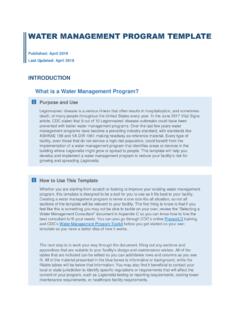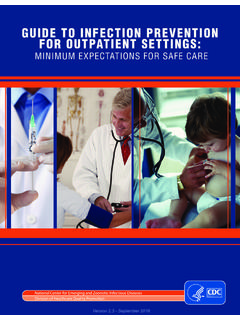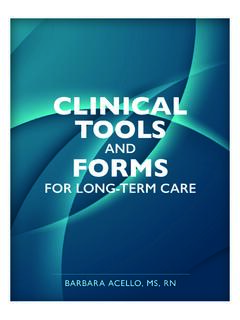Transcription of Healthcare Facility Water Management Program Checklist
1 Updated: 11/17/2021 Page 1 of 4 Healthcare Facility Water Management Program Checklist Available from: This Checklist is intended to assist in the development of an all-hazards approach to Water Management in a Healthcare Facility , and may be used to: Evaluate a comprehensive Water Management Program . Identify individuals to participate in the Water Management Program . Assist in conducting assessments, including hazard analyses, environmental risk assessments, and infection control risk assessments. Inform Water monitoring practices guided by the Management Program . Depending on complexity of the building plumbing systems, a comprehensive Program may include several Water Management plans. These plans should include areas within the system where control points are identified as well as monitoring methods and procedures.
2 Establish a Water Management Program Team For all Facility types, establish clear lines of communication to facilitate dialogue with representatives from the Water utility/drinking Water provider, as well as the local health department, on an as needed basis. Define membership (at a minimum, the following roles should be represented; may include others depending on Facility size, type Facility administration/ownership or C- Suite facilities Management facilities engineer infection prevention Develop a charter that defines roles and responsibilities of members, chair, meeting schedule, etc. Have you identified team members who should: Y N Be familiar with the Facility Water system(s) Y N Identify control locations and control limits Y N Identify and take corrective actions Y N Monitor and document Program performance Y N Communicate to the C-suite, staff, health department, and representatives of the drinking Water supplier (if needed) Y N Oversee the Program Y N Access necessary resources to implement changes Develop the Water Management Policies and Procedures, Plans, and Protocols Describe your building Water systems Text description of the building Water systems, campus Water systems, etc.)
3 Develop flow diagrams that describes these systems For nursing homes, the group may consist of three or more individuals representing Management , nursing (someone filling the role of infection control ), and the facilities engineer; ad hoc members with subject matter expertise (to provide advice) may be Water consultants. Larger facilities representation may include a designee from the C-suite, risk Management , infection prevention , facilities engineers, central services, laboratory, and ad hoc members from clinical departments or Water consultants. Updated: 11/17/2021 Page 2 of 4 Healthcare Facility Water Management Program Checklist Identify external hazards ( , compromised supply) and describe plans for mitigating or managing these events: Trace or no disinfectant residual upon entry into the building Water main breaks Low pressure events Flushing hydrants Boil Water Advisory Nearby construction Other (specify): Identify areas where biofilms may be present and areas where opportunistic pathogens of premise plumbing may grow and spread Identify storage tanks and describe ( Water turnover rates, residence times, etc.)
4 Identify areas of stagnation (dead legs, vacant units/rooms, etc.) Identify areas with hand-held showers, faucets with aerators/flow restrictors, Identify areas with no residual disinfectant Identify areas where temperatures can support microbial growth Identify locations of commodes and hoppers Y N Do all commodes and hoppers have covers that can be closed when flushing? Y N If no cover present, are they located in a separate room with a door that can closed? Identify sinks and sink locations Y N Do sinks in patient care areas have aerators and flow restrictors? Y N Identify electronic sinks/faucets and temperature setting for mixing valve Y N Do all sinks in patient care areas have drains that are offset from faucet flow stream? Y N Are there barriers (splash guards) between sinks and adjacent medication preparation areas and patient supplies?
5 Y N If splash guards are not present, is medication prep and clean supply storage > 3 feet from sinks? Conduct an Infection control Risk Assessment (ICRA Adapt for potential Water exposures both direct and indirect) Identify patients at increased risk ( , burn patients, patients with immune suppression, patients with lung disease /injury, patients with indwelling devices ( , central venous catheters, peritoneal dialysis catheters, etc.), patients with open wounds, patients undergoing endoscopy, etc.) Risk stratify procedures and processes Identify potential exposures to Water See From Plumbing to Patients: Water Management programs for Healthcare Facilities ( ) Updated: 11/17/2021 Page 3 of 4 Healthcare Facility Water Management Program Checklist Identify control point locations and determine how control measures will be applied using both the environmental assessment and ICRA Decide how to monitor control measures (some examples) Water temperature See: Guidelines for Environmental Infection control in Healthcare Facilities ( ) Residual disinfectant Heterotrophic plate count (HPC) Total Organic Carbon Review trend data and report out of control results Determine frequency for monitoring Other (specify).
6 Set control limits for control measures that will be monitored ( Water temperature, residual disinfectant, HPC, and/or total organic carbon). Corrective Actions (some examples) Eliminate dead legs, unused branches Remove or repurpose high risk features ( , Water features, decorative fountains) Flush taps/fixtures in vacant rooms Decontamination (shock treatment or remediation using supplemental treatment for short period of time) Change fixtures/hand held showers Point of use filtration; supplemental building disinfection systems Routine and intermittent supplemental disinfection (requires registration with State drinking Water Program ); once one starts to treat Water Facility is now a small drinking Water utility subject to drinking Water regulations Raise hot Water temperature if in tepid zone (16 C - 38 C) Other (specify): Outbreak and Contingency Response Plans Ability to detect, investigate, and respond to a sentinel infection or cluster that is potentially linked to a Water source Collect epidemiologically linked samples Notify Health Department Arrange for molecular typing or relatedness testing Reassess Water control measures and apply corrective actions See also HAI Outbreak Investigation Toolkit ( ) Tap Water Quality and Infrastructure Discussion Guide for Investigation of Potential Water -Associated Infections in Healthcare Facilities (PDF - 5 Pages) ( ) Updated.
7 11/17/2021 Page 4 of 4 Healthcare Facility Water Management Program Checklist Verification: has the plan been implemented as designed and are you following it? Validation: Determine what conditions, outcomes inform you that your Program is effective Perform clinical surveillance for infections due to opportunistic pathogens of premise plumbing See: From Plumbing to Patients: Water Management programs for Healthcare Facilities ( ) Identify clusters and conduct an epidemiologic investigation Routine environmental sampling for Legionella (optional consideration) Base decisions on building environmental assessment, Water quality data, and context of whether disease is present or absent: Legionella Routine Environmental Sampling ( #env-sampling). Documentation Team Roster: Names, titles, contact info, team responsibility, member roles Building Description: Location, building age, use, occupants, visitors, bed occupancy rate, additions or renovations, etc.
8 Water system description: both text and process diagrams, location of attached equipment control Measures: identify control measures, locations in the system where critical limits can be monitored and where controls can be monitored and applied Confirmatory procedures: verification steps, and validation to show effectiveness of the Water Management plan as designed Sampling and testing: document collection and transport methods, chain of custody, and laboratory identified performing assays if environmental testing is conducted, results Communication Plan Notification to building staff/occupants that a plan is in place and provide team s contact info; issue regular updates as plan is implemented or modified Reports to team, infection control , hospital administration, other affected parties if control limits are exceeded, and corrective actions to be applied Consider quarterly and annual reports: reports to Management and occupants, consider part of Facility quality review; since activity is part of Continuous Quality Improvement (CQI).
9 Notification protocols with public health points of contact for when a sentinel infection or cluster is detected.















